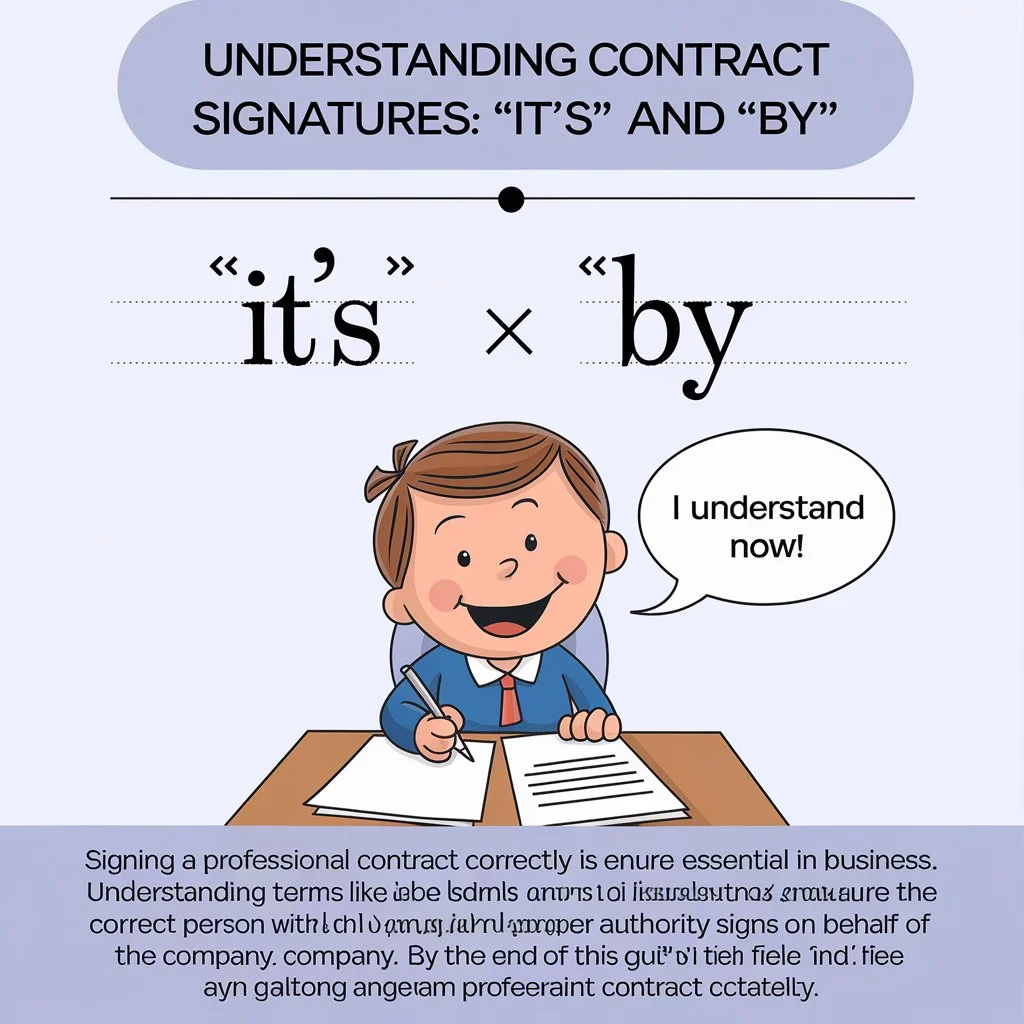A contract’s signature line can be confusing if you’re unfamiliar with its structure. Signing a professional contract incorrectly can lead to misunderstandings, so it’s essential to understand terms like “its” and “by” that often appear in the signature line. These terms help ensure that the correct person, with the proper authority, signs on behalf of the company. Let’s break down the differences, explain why they’re used, and clarify how you should sign to avoid any mistakes.
Understanding the correct way to sign a contract is essential in business to ensure agreements are valid and binding. Many contracts contain specific language, such as “its” and “by,” that indicate how the signer represents their company. These terms might seem confusing at first, but they are crucial in identifying the signatory’s authority. In this guide, we will clarify their usage and address common questions about contract signatures. By the end, you’ll feel confident in signing any professional contract correctly.
What Do “Its” and “By” Mean on a Contract’s Signature Line?
The term “Its” is used when you’re signing on behalf of a company, and you need to list your title or position within that company. It could also be written as “title,” though “title” is often reserved for individuals signing for themselves rather than on behalf of a company. “By” is used to indicate where your actual signature should go when you’re signing for a company. Together, “its” and “by” clarify the signatory’s authority, ensuring they have the correct authorization to represent the company.
Without these designations, a contract might lack professionalism and lead to complications. The use of both “its” and “by” ensures that the correct person is signing on behalf of the company, reducing the chance of unauthorized individuals signing contracts, which could result in major issues for both parties involved.
Typically, higher-ranking individuals within a company sign contracts, and their role or title is captured in the “its” or “title” field. These terms are often used interchangeably, but you will always see “by” on the signature line. The “by” line is essential and cannot be replaced, though the “its” field might have other variations like “title” or “position.”
Example Contracts Using “Its” and “By” (Filled Out)
Let’s look at some filled-out examples to see how “its” and “by” are applied. These examples will help you know exactly where to sign and input your job title:
Example 1:
NAME OF COMPANY IN CHARGE OF CONTRACT
By: John Doe (a signature is signed here)
Print: John Doe (the printed name goes underneath the signature for clarification)
Its: CEO (the job title of the person representing the company)
Example 2:
NAME OF COMPANY IN CHARGE OF CONTRACT
By: Jane Stone (a signature is signed here)
Print: Jane Stone (printed name under signature)
Its: Director (job title of the person representing the company)
Example 3 (Blank):
NAME OF COMPANY IN CHARGE OF CONTRACT
By: ________________
Print: ________________
Its: ________________
Why “Its” Is Used on a Contract Signature Line
The term “its” is the possessive form of “it”, which is used when something belongs to another thing. In the context of a contract, “its” refers to the company that the signatory represents, and the title or role of the signer within that company. Think of the sentence: “The signer is John Doe of Company A, and John Doe is its CEO.” In this case, “its” shows the signer’s position or authority within the company.
Example Contracts Without “Its” and “By”
Not all contracts use “its” and “by.” Some companies create their own variations for contract signature lines, but these examples serve the same purpose. Let’s look at some alternatives:
Samples
NAME OF COMPANY IN CHARGE OF CONTRACT
Name: ________________
Printed: ________________
Title: ________________
In this example, “name” replaces “by” for the signature, and “title” replaces “its.”
NAME OF COMPANY IN CHARGE OF CONTRACT
Signed: ________________
Printed: ________________
Position: ________________
Here, “signed” is used instead of “by,” and “position” is used instead of “its.”
NAME OF COMPANY IN CHARGE OF CONTRACT
Signed by: ________________
Printed: ________________
Role: ________________
This form uses “signed by” instead of “by,” and “role” replaces “title.”
NAME OF COMPANY IN CHARGE OF CONTRACT
Signature: ________________
Printed: ________________
The: ________________
In this case, “signature” clearly indicates where to sign, and “the” substitutes for “its,” though this is a rarer format.
NAME OF COMPANY IN CHARGE OF CONTRACT
Representative: ________________
Printed: ________________
Authority: ________________
This contract asks for the signatory’s “representative” signature and their “authority,” or position, in the company.
Why “By” Is Used Instead of “Signature”
The term “by” is often preferred over “signature” for several reasons:
- Efficiency: “By” is shorter and saves space (and ink) on documents, particularly when printing large quantities of contracts.
- Familiarity: Many people are already accustomed to seeing “by” on a signature line, and it has become the standard way to request a signature.
However, the choice between “by” and “signature” is up to the company. While “by” is more common, some companies may opt for “signature” for clarity.
Common Contract Terms That May Confuse You
Contracts are often full of legal and formal language that can confuse readers. Here are a few commonly misunderstood terms and their meanings:
- Assure vs. Ensure: Assure means to convince someone, while ensure means to make certain something happens.
- Affect vs. Effect: Affect means to alter or change something, whereas effect refers to the result of a change.
- i.e. vs. e.g.: i.e. means “that is,” while e.g. means “for example.” Make sure you understand the difference, as they often appear in contracts.
Understanding contract terminology like “its” and “by” is crucial for signing contracts correctly. Whether you’re signing for a company or representing yourself, knowing these terms ensures that the correct person signs with the appropriate authority. When in doubt, refer to the specific contract’s structure and always seek clarification if necessary.
FAQs
What does “by” mean on a contract’s signature line?
The term “by” on a contract’s signature line is where the actual signature goes. It indicates who is signing the contract, often on behalf of a company. By signing next to “by,” you’re asserting that you have the authority to execute the contract on behalf of the organization. This ensures clarity about who is responsible for the agreement and prevents unauthorized individuals from signing. Always ensure that your printed name and title appear clearly to avoid any confusion.
What does “its” mean on a contract’s signature line?
“Its” refers to the title or position of the person signing the contract on behalf of the company. For example, if you’re a CEO signing a contract, you would write “its CEO” in this space. It establishes that you’re signing with the necessary authority granted by your role. This helps clarify that the contract is being signed by the appropriate individual within the company. Without “its,” the title and authority of the signer may be unclear, which could raise concerns during contract enforcement.
Can I use “signature” instead of “by” on a contract?
While “signature” can sometimes replace “by,” “by” is more commonly used in professional contracts. Some companies prefer “by” because it’s a shorter, more streamlined way to indicate where the signature should go. However, both terms essentially serve the same purpose: to signify the act of signing. The choice between the two typically depends on the company’s formatting preferences. Be sure to follow the specific instructions laid out in the contract you’re signing.
Why is “its” used instead of “title”?
“Its” is used in place of “title” to indicate the possessive relationship between the company and the position of the person signing. For instance, when you sign as a Manager for a company, “its Manager” shows that you hold the title of Manager within the company. Using “its” helps establish that the individual signing represents the company in an official capacity. In many cases, contracts use “its” as a formal way of demonstrating this link.
What happens if the wrong person signs a contract?
If the wrong person signs a contract without the proper authority, the contract may be considered invalid or unenforceable. This is why it’s crucial that the signatory has the legal right to bind the company to the terms of the agreement. Contracts signed by unauthorized individuals can lead to disputes, and the other party may refuse to honor the agreement. To avoid this, ensure that the individual signing has the proper title and authorization from the company.
Do all contracts use “by” and “its”?
Not all contracts use the specific terms “by” and “its.” Some contracts may use alternatives such as “signed,” “name,” or “title.” The structure can vary depending on the company’s formatting preferences or the specific nature of the contract. However, the purpose of these terms remains the same: to clearly indicate who is signing and their authority within the company. Always read the contract carefully to understand the specific signature requirements.
Conclusion
Mastering the correct way to sign a contract is critical for protecting both you and your company. Understanding the meanings of “by” and “its” ensures that you’re signing with the proper authority and fulfilling legal obligations. These simple yet crucial details can prevent future complications and ensure that your contracts are legally binding. Remember, each contract might have its own specific formatting, but the principles remain the same. As the saying goes, “An agreement is only as strong as the authority behind the signature.”

I’m Clara Whitmore, the girl running the show at “Grammer Grove.” I’ve been playing with expressions and formats to make grammer a whole lot of fun. Over at Grammer grove, we’re here to make your English grammer incredible. Let’s add some professionalism and gratitude to yourwritting together!












